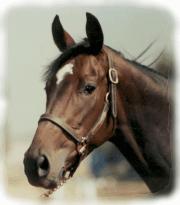A Horse, of Course with Don Blazer |
If you enjoy learning about horses, then you'll love our online courses. Each month you'll find a new column on our web site. We hope you'll enjoy it, and maybe e-mail us with questions or suggestions for other columns. A Horse, Of Course is a monthly column syndicated by Success Is Easy. If you like the column, call your local newspaper, or local horse publication and ask them to subscribe by contacting Success Is Easy. |
A Strange Phenomenon Don Blazer copyright©2012 |

Horses seldom burp! A real rogue, who has no social conscience and most likely has been gulping air along with his food, will, on occasion, burp. But for the most part, horses don’t. It’s not that they are so polite. It’s that their digestive system is geared for one-way traffic only, and burping is therefore against their nature. The equine digestive system plays a major role in the horse-mankind relationship. It was the horse’s digestive system which helped the horse become a working partner rather than dinner. Cattle were the first work animals, and horses supplied man’s meat and milk. But the digestive system of cows made it necessary for them to lie down and ruminate (chew their cud) during work hours. All these short breaks slowed progress, so man switched his attention to horses which don’t need “digestive time off.” The horse’s digestive system is made up of the alimentary canal…a muscular tube extending from the mouth to the anus—and the accessory organs, which are teeth, salivary glands, liver and pancreas. The horse is a polite, slow eater, and will spend time chewing his food. During the chewing the food absorbs saliva which aids in swallowing and triggers a chemical reaction that starts the digestion of starches and sugars. Food passed from the mouth the pharynx is trapped. The food cannot return because at the rear of the mouth is the soft palate, a kind of curtain separating the mouth from the pharynx. The soft palate opens only on swallowing, and, in effect, provides a one-way flow of food. (This is also the reason horse’s don’t breathe through the mouth as so many other animals do.) From the pharynx the food goes to the esophagus, a 50 to 60 inch long tube which runs down the left side of the horse’s neck to the stomach. The muscles of the esophagus work in successive constriction waves in only one direction, making it nearly impossible for the horse to vomit. Anything which gets into the esophagus is going to the stomach. The stomach is a small muscular sac located in the abdominal cavity. The stomach is small (about the size of a football) because the horse is a constant eater with no need for large capacity. The stomach works in a compressive manner and provides some digestive enzymes, but food begins to pass out of the stomach as soon as it is about two-thirds full. The small intestine is next….about 70 feet long. The digestive process continues here where enzymes from the pancreas and bile from the liver are added. The large intestine is last. It is divided into four parts: the caecum, large colon, small colon and rectum. The greater size of the large intestine allows the food to move along more slowly while final digestion takes place. A system of veins along the large intestine channels the greater portion of the food-enriched blood to the liver, which is the major chemical conversion plant. The liver regulates the distribution of nourishment. While not too complicated, the digestive system of the horse does require some special care. That care is primarily seen in the horse owner’s feeding program. The time of feeding, quality of roughage, correct amount of food for the size of the horse, provision of adequate water and manner of feeding are vitally important to the good health of the horse and normal functioning of digestion. Remember the horse is a constant eater, so he can’t stand big gaps of time without food…and his small stomach isn’t geared for “loading up, and then having nothing”. If the feeding program is bad, it’s mighty tough on the horse. There’s no “plop, plop, fizz, fizz” for the horse’s upset digestive system. And he seldom gets the relief of a good burp! |